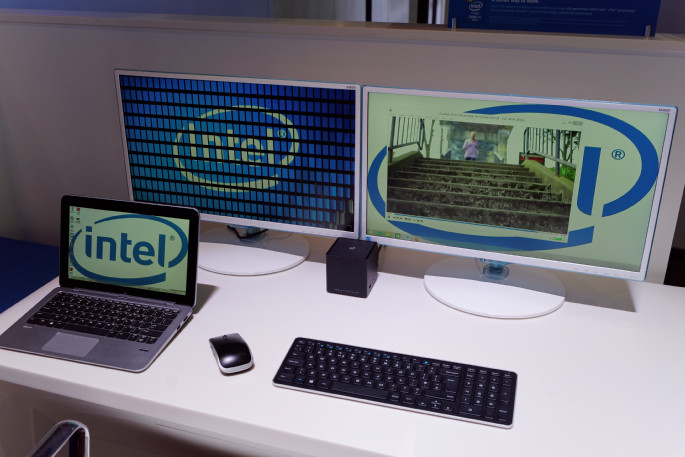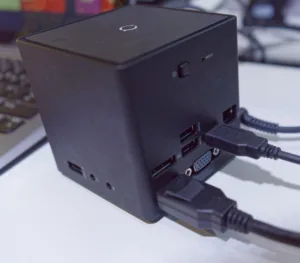Back in the spring of 2012, for my market research clients, I looked at the topic of wireless connections to displays. It has seemed to me, for some years, that the increasing miniaturisation of electronics and the dominance of the smartphone was likely to eventually lead to the processing power and access to data (whether local or in the cloud) would be through the mobile device that will be universally carried in the pocket.

The smartphone is, after all, a classic disruptive technology, that started as much less powerful and functional than a PC, but by weight of sales volume, will develop to push PC technology into a niche, albeit a relatively big one. It seemed clear to me that at some point in the future, much of the personal data and apps that users want to access will be in the mobile device. It also seemed clear that in the future the mobile device would have access to all my “stuff”, but that in the home or office users would need bigger displays than their smartphones. The lesson of netbooks was that, for productivity purposes, you really need a good sized display.
One of the disadvantages of the smartphone form factor is the difficulty of putting connectors onto the device. The slim form factor makes it tricky, especially if you need multiple connectors for different functions such as display or other peripheral connections. The obvious move, then, is to go wireless to eliminate connectors. The use of wireless is, however, heavily regulated, so, in the end if you want to connect wirelessly, you have to use “unlicensed” spectrum, which means there are only a few frequency bands that are available worldwide, without having to go through detailed and separate approval processes in each country.
When you start to try to transmit display data from a device to a screen, a lot of bandwidth is needed* – from 3Gigabit/sec for 1920 x 1080 at 60Hz with 8 bit colour (or nearly 36 gigabits if you go to UltraHD [3840 x 2160] with 12 bit HDR colour and 120Hz refresh!). There are two ways to approach this.
You can compress the data and send it down a relatively small broadcast “pipe” – that’s the approach taken by Intel with its WiDi and by Miracast which both use the unlicensed 2.4GHz and 5GHz Wi-Fi wavebands. It works pretty well for streamed content, where the latency induced by the compression and decompression doesn’t cause a problem, and for video content. However, graphic content can show some artefacts and latency is a problem for interactive applications, so it’s not really appropriate for mainstream computing.
The second approach is to find a “fat pipe” and that means higher frequencies. The band that a number of companies were working on in 2012 was the 60GHz band. One of the candidates was WiGig from Israeli company, Wilocity. This looked like a good prospect for a solution especially as, in 2010, deals with the Wi-Fi Alliance and VESA were announced.
At CES in 2013, the WiGig Alliance told us that it would merge with the Wi-Fi Alliance and this came to pass in March 2013. WiGig started the process of becoming part of the next Wi-Fi standard – 802.11ad and in 2014, Qualcomm bought Wilocity. At the Mobile World Congress (MWC) in Barcelona last month, Qualcomm was demonstrating several use cases for the WiGig features.
One of the key features of WiGig is that along with the high bandwidth, it allows a level of Quality of Service (QoS) control. While typical data and file transfers are not usually sensitive to the precise time of arrival of a particular part of the data, displays are very sensitive to this.
At MWC, One of the use cases that Qualcomm showed was for the wireless docking of a notebook computer. At CeBIT last week, we saw a real product offering this function.
 HP’s Wireless Dock on the Intel booth at CeBIT
HP’s Wireless Dock on the Intel booth at CeBIT
HP was on the Intel booth and showing its Advanced Wireless Docking Station. When used with the HP Elite x2 convertible and the Intel Tri Band Wireless AC with WiGig Combo card (included in the 1011 G1 Tablet version for $949), the dock allows wireless connectivity for dual FullHD displays, Ethernet, USB and audio.
 At these high frequencies, range is limited and the HP dock is warranted for just 1.2 m (4′) range, although staff at CeBIT told us that the realistic range at the show was around 3m (10′). Because the wireless card is in the display part of the convertible, it can be used when the PC is being used in its tablet mode.
At these high frequencies, range is limited and the HP dock is warranted for just 1.2 m (4′) range, although staff at CeBIT told us that the realistic range at the show was around 3m (10′). Because the wireless card is in the display part of the convertible, it can be used when the PC is being used in its tablet mode.
The dock costs €199 ($239 in the US) and is shipping now.
It seems to me that this product represents an inflection point. Going forward, the addition of wireless charging would mean the opportunity to create fully wireless docking. By 2016, when smartphones will start to include 802.11ad, they will be usable with full size keyboards, mice and even wired ethernet when connected via this kind of dock. Although the range is limited, for docking applications this will not be an issue, in fact it will be an advantage in environments where lots of systems need to dock as there will be less interference.
Bob
* It has seemed to me for many years that for most office applications, most of the time, the display is largely static, so it is sensible to have some memory in the display and only send the changes. This approach is developing for mobile applications (see Panel Self Refresh – a feature of the eDP DisplayPort spec) but has never made to the mainstream for desktop displays.

